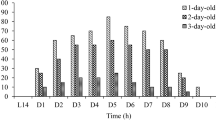Abstract
Avoidance of occupied ovisposition sites supposes that females perceive information related to their own progency. Fatty acids identified from egg extracts have been reevaluated using a different extraction method, and we have investigated the dose-dependent oviposition response of European grape vine moths (Lobesia botrana) to myristic acid, palmitic acid, palmitoleic acid, stearic acid, oleic acid, linoleic acid, methyl palmitate, methyl oleate, and ethyl palmitate; all except ethyl palmitate have been identified from eggs ofL. botrana. A methylene dichloride extract of eggs fromL. botrana revealed the presence of saturated free fatty acids (myristic, palmitic, and stearic) and unsaturated acids (palmitoleic, oleic, linoleic, and linolenic) in amounts ranging from 3.9 ng/egg equivalent for myristic acid to 30 ng/egg equivalent for palmitic and oleic acids. The extract also contained traces of methyl palmitate and methyl stearate. The greatest avoidance indexes were observed in response to palmitic, palmitoleic, and oleic acids. All the other compounds tested caused weaker responses. A reduction in the number of eggs laid was observed when moths were exposed to each of the esters applied at 0.3 µg per application spot. Reduction in eggs laid was also observed at a 10-fold higher dose of oleic acid. The present results confirm that general and simple molecules can be involved in the regulation of oviposition site selection and that they may participate in chemical marking of the eggs.
Similar content being viewed by others
References
Andersen, P. 1986. Oviposition-deterring pheromones in insects. Introductory paper No. 45, Lund University, Sweden, 21 pp.
Frenoy, C., Durier, C., andHawlitzky, N. 1992. Effect of kairomones from egg and female adult stages ofOstrinia nubilalis (Hübner) (Lepidoptera, Pyralidae) onTrichograma brassicae Bezdenko (Hymenoptera, Trichogrammatidae) female kinesis.J. Chem. Ecol. 18:761.
Gabel, B., andThiéry, D. 1992. Biological evidence of an oviposition-deterring pheromone inLobesia botrana Den. et Schiff. (Lepidoptera, Tortricidae).J. Chem. Ecol. 18:353–358.
Gabel, B. andThiéry, D. 1994. Semiochemicals fromLobesia botrana eggs deter oviposition by the codling moth (Cydia pomonella).Eur. J. Entomol. 91:353–359.
Hwang, Y.S., Schultz, G.W., andMulla, M.S. 1984. Structure-activity relationship of unsaturated fatty acids as mosquito ovipositional repellents.J. Chem. Ecol. 10:145–151.
Peters, T.M., andBarbosa, P. 1977. Influence of population density on size, fecundity and developmental rate of insects in culture.Annu. Rev. Entomol. 22:431–450.
Prokopy, R.J. 1981. Epideictic pheromones influencing spacing patterns of phytophagous insects, pp. 181–213,in D.A. Nordlund, R.L. Jones, and W.J. Lewis (eds.). Semiochemicals—Their Role in Pest Control. Wiley & Sons, New York.
Renwick, J.A.A. 1989. Chemical ecology of oviposition in phytophagous insects.Experientia 45:223–228.
Rickli, M., Guerin, P.M., andDiehl, P.A. 1992. Palmitic acid released from honeybee worker larvae attracts the parasitic miteVarroa jacobsoni on a servosphere.Naturwissenschaften 79:320–322.
Roitberg, B.D., andProkopy, R.J. 1987. Insects that mark host plants: an ecological evolutionary perspective on host marking chemicals.BioScience 37:400–406.
Siegel, S. 1956. Nonparametric Statistics for Behavioral Sciences. McGraw-Hill, New York. 312 pp.
Thiéry, D., andGabel, B. 1993. Inter-specific avoidance of egg-associated semiochemicals in four tortricids.Experientia 49:998–1001.
Thiéry, D., andLe Quéré, J.L. 1991. Identification of an oviposition deterring pheromone in the eggs of the European corn borer. Naturwissenschaften 78:132–133.
Thiéry, D., Gabel, B., Farkas, P., andPronier, V. 1992. Identification of an oviposition-regulating pheromone in the European grapevine moth,Lobesia botrana (Lepidoptera: Tortricidae).Experientia 48:697–699.
Thiéry, D., Gabel, B., Farkas, P., andJarry, M. 1995. Egg dispersion in the codling moth: Influence of egg extract and of its fatty acid constituents.J. Chem. Ecol. 21:2017–2028.
Trouiller, J. 1993. La communication chimique intra- et interspécifique chez l'abeille: Relations abeille varroa, couvain ouvière. Thése Doc. Univ., University of Paris 7. 146 pp.
Author information
Authors and Affiliations
Rights and permissions
About this article
Cite this article
Gabel, B., Thiéry, D. Oviposition response ofLobesia botrana females to long-chain free fatty acids and esters from its eggs. J Chem Ecol 22, 161–171 (1996). https://doi.org/10.1007/BF02040207
Received:
Accepted:
Issue Date:
DOI: https://doi.org/10.1007/BF02040207




